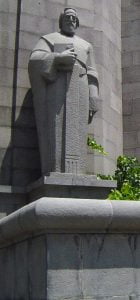Movses Khorenatsi (also spelled Khorenatzi; Armenian: Մովսես Խորենացի), often hailed as the “Father of Armenian History” (Patmahayr), was a 5th-century Armenian historian, scholar, and clergyman whose monumental work shaped Armenian national identity and historical consciousness.
He is best known for authoring The History of Armenia (Patmut’yun Hayots’), one of the earliest comprehensive historiographical works in Armenian literature. Commissioned by Prince Sahak Bagratuni, this chronicle traces the history of the Armenian people from the legendary patriarch Hayk to the 5th century AD. Drawing from oral traditions, ancient legends, Greek and Syriac sources, and early Christian writings, Khorenatsi crafted a detailed narrative that not only preserved the pre-Christian heritage of Armenia but also placed it within a Christian and classical historical framework.

His writings remain invaluable for understanding ancient Armenian mythology, the genealogy of noble houses, and Armenia’s early Christian transformation. Khorenatsi’s nuanced storytelling, combined with a critical use of sources, has earned him a revered place not only in Armenian scholarship but in the broader context of Late Antique historiography.
Movses was reportedly born around 410 AD in the village of Khorni in the province of Taron (though some traditions claim Syunik, in the village of Khorena, in the region of Harband, as his birthplace). He received his early education in Syunik and later pursued advanced studies in Alexandria, Egypt, one of the leading intellectual centers of the ancient world. This classical education is reflected in his erudition and rhetorical style.
Khorenatsi’s History does more than chronicle events—it conveys a vision of Armenian destiny, linking Armenia’s past with its Christian mission and its place in world history. Despite ongoing scholarly debates regarding the precise dating of his work, his influence on Armenian national identity remains unquestioned.
Movses Khorenatsi’s legacy endures in Armenian historiography, theology, and literature. His works continue to be studied, translated, and referenced, making him one of the most enduring figures in Armenian intellectual history.

